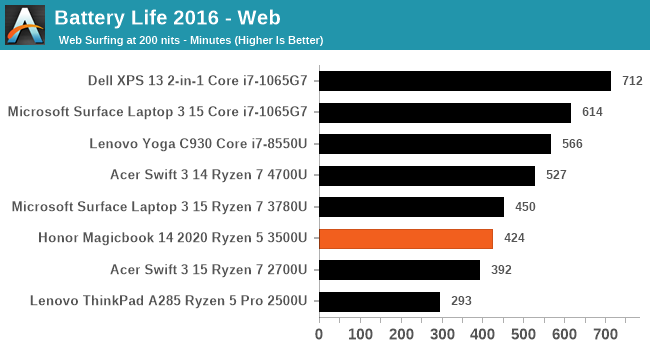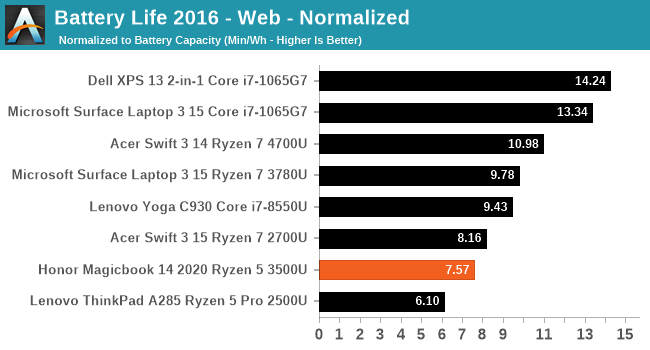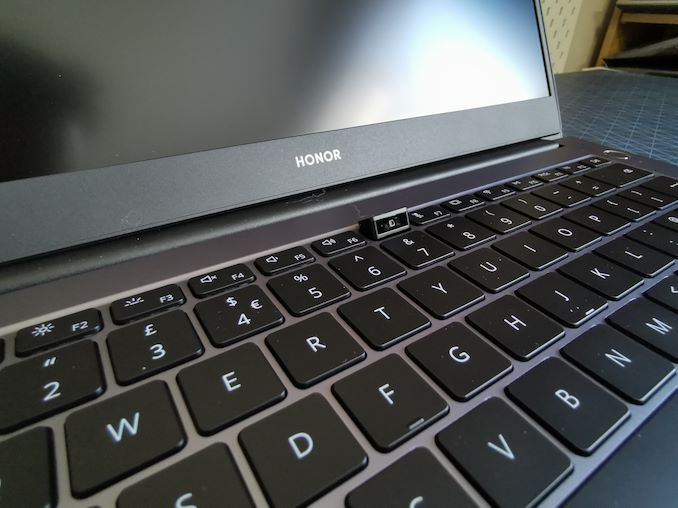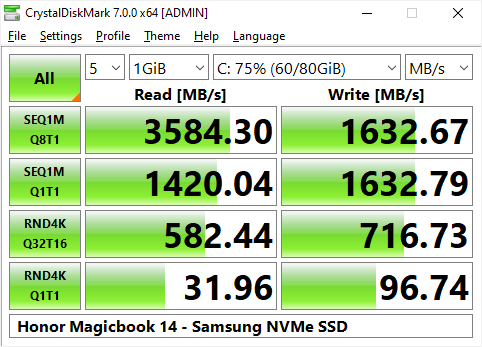Honor Magicbook 14 Notebook Review: Where Style Paints a Picasso
by Dr. Ian Cutress on May 15, 2020 9:00 AM EST- Posted in
- Laptops
- AMD
- Notebooks
- Zen
- honor
- Picasso
- MagicBook
- Magicbook 14
- Ryzen 5 3500U
Battery, Display, and Storage
Battery
One of the key differentiators with AMD’s newer Renoir mobile processor line is the better battery life. The battery life of devices using AMD’s Picasso mobile processors, as used here in the Honor Magicbook, has depended a lot on the implementation as well as the components of the system being used. The OEM has to be able to set up the system to get to idle quickly, and remain there. Nonetheless, the idle power consumption also needs to be low, not only for the CPU, but for the system, which means using efficient LCD panels where possible, and efficient controllers.
Honor claims that the Magicbook 14, with its 56 Wh battery, should be good for 9-10 hours of web/movie/office work, although this value is when the display is at 150 nits using MobileMark2014. For our test, as with our other laptops, we put the display at a more user-friendly 200 nits and run our web-app based light workload.

The Honor Magicbook 14 lasts 7 hours and 4 minutes in our test, or 424 minutes. This puts it ahead of the first gen Ryzen 2000 APUs, but behind the newer Ryzen 4000 APUs. The battery life of the Ryzen 7 in the Microsoft Surface Laptop with the same generation processor is quite near, however as we can see they are all a bit below what the intel systems can provide.

If we normalize for the battery capacity, then we are a bit further behind the AMD-based Surface Laptop than intended, and even behind the Acer Swift 3 with the Ryzen 7 2000 series.
Display
Inside the Honor Magicbook is a 1920x1080 non-touch LCD display, with ~5mm bezels. The webcam for the laptop is not in the display frame, but in a pop-up key between the F6 and F7 keys. Personally I’m not a fan of this webcam, because it means all you get is nose shots when using it on calls. However based on customer feedback, Honor (and Huawei, who use the same idea) says that their customers prefer having one there rather than not having one at all, like on the ASUS Zephyrus G14.
For the display, we measured a peak brightness of 240 nits, which is actually really low. Honor does not list an official brightness for the screen, but we suspect around ~250 nits, and this is perhaps one of the areas that helps bring the cost of the system down to $560. For color accuracy, with the system as shipped, it was not good at all:
After we applied a color calibration tool, the end result was almost ideal:
Storage
One of the highlights on this system is that Honor only have SSD options – not only that, they are Samsung NVMe PCIe 3.0 x4 SSDs. Someone at Honor is smart, and this helps the system in a lot of user responsiveness type scenarios. I had no issues.
The drive is the Samsung MZVLB256HAHQ, which translates as the PM981 with the Phoenix controller and Samsung TLC NAND. The drive is rated at 2.8 GB/s read and 1.1 GB/s write, but we achieved 3.6 GB/s read and 1.6 GB/s write, a substantial gain. This drive over at Amazon is $64, representing more than 10% of the cost of this system.















88 Comments
View All Comments
sonny73n - Sunday, May 24, 2020 - link
These trailer trashes think they invented everything. They ignore history and claim it’s all theirs as soon as a company in their country put it on a product. They don’t care the facts that many inventors working in their country are nationals that’s not the same as theirs. They claim it all whether it was stolen, robbed, bought, scammed... from others. They’re the exceptionals who has successfully fooled themselves.Xajel - Sunday, May 17, 2020 - link
This with Renoir, 4700U or 4800U (or both as options) will be the ultimate one to look for. Especially if they could add upgradable RAM to it (like 8GB or 16GB embedded and a single SODIMM).deil - Monday, May 18, 2020 - link
this is bad config. ssd is very close to heat source, and will get hot without use. it will shorten the lifespan a lot.Spunjji - Monday, May 18, 2020 - link
Not really. The flash on SSDs suffers more from cold than it does from heat, and it's extremely unlikely that a device like this will be put to such a use that the SSD controller would begin to throttle.Findecanor - Tuesday, May 19, 2020 - link
I would like to know if the type of charging this laptop uses is compatible with the USB Power Delivery standard, and what capacity it uses then.It is 2020, and today there is no way that I am going to buy any device that does not follow the standard. I don't want to carry five different chargers on the road.
dickeywang - Tuesday, May 19, 2020 - link
It comes with AMD graphics, which means better support in Linux. :)quadibloc - Thursday, May 28, 2020 - link
Taking Michael Kovrig and Michael Spavor hostage is dishonorable.sonny73n - Wednesday, August 12, 2020 - link
“The keyboard is an attempt to copy Apple’s chiclet design.”Even Anandtech believed the lie when it repeated enough of times.
Sorry to burst your bubbles. The chiclet keyboard was designed by Sony on the Vaios. Check products release dates on Google, you’ll be surprised how much Apple stole from others, not the other way around. Keep gobbling that BS from MSM.